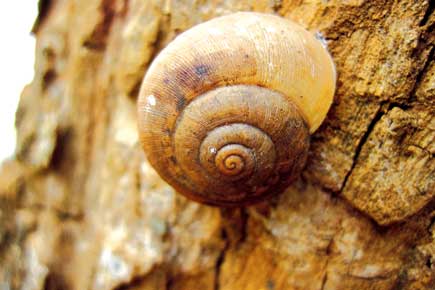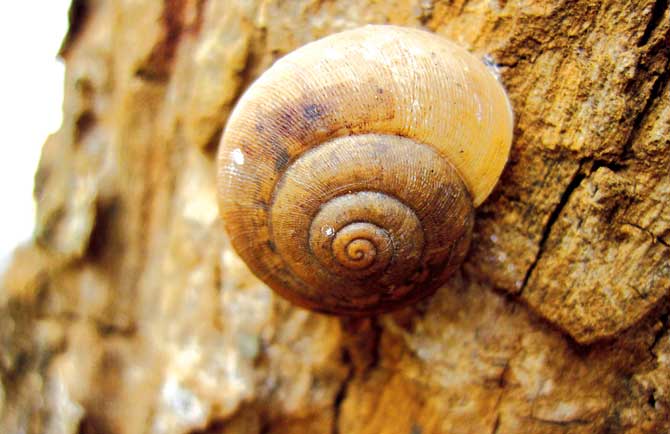The world is going crazy, attempting to surpass the speed of sound and reach places at break-neck speed. Then, along comes a snail, slipping along at an easy pace. It makes you wonder, would the world be any different if we all slowed down instead of hurtling mindlessly through life

Snails are excellent indicators of climate and ecological change as they are sensitive to minor variations in soil pH, temperature, humidity etc
 The world is going crazy, attempting to surpass the speed of sound and reach places at break-neck speed. Then, along comes a snail, slipping along at an easy pace. It makes you wonder, would the world be any different if we all slowed down instead of hurtling mindlessly through life?
The world is going crazy, attempting to surpass the speed of sound and reach places at break-neck speed. Then, along comes a snail, slipping along at an easy pace. It makes you wonder, would the world be any different if we all slowed down instead of hurtling mindlessly through life?
Another pertinent question that plagues me is do snails really go slow or are they running at full throttle as far as they are concerned? What is the yardstick for comparison — shouldn't a snail be pitted against other snails instead of a hare, cheetah or honeybee?
ADVERTISEMENT
If we ignore the speed aspect for a while and focus on sheer diversity, with over 1.5 lakh described species, Phylum Mollusca — to which land snails or terrestrial gastropods (meaning leg filled with air) belong - is the world's second largest group after Phylum Arthropoda. Although there is a far higher diversity of molluscs in marine and fresh water environments, humans largely come in contact with terrestrial gastropods.
Sadly, when studying the impact of development and related biodiversity loss, much focus is levied on plants and vertebrates, thus, completely ignoring the most biodiverse invertebrates. The fact that land snails count for nearly six per cent of all land creatures and have the largest number of documented extinctions compared to any other taxa (group of creatures), is of deep concern.
Most snail species are at risk due to human activities — construction, pollution, use of pesticides, shifting agriculture, planting exotic trees and excess use of herbicides. But, the most critical threat to land snails comes from the narrow distributions and home ranges.
India has around 1,500 recorded species of land snails out of which over 270 species are found in the Western Ghats, passing through Mumbai, Thane, Kalyan and Navi Mumbai. Some snails are restricted to ranges as small as 5 sq km and to a maximum of 100 sq km. Due to their low dispersal capacity, even a single metro yard, dam, mine, tunnel or railway station project can spell doom to several species, leading to mass extinction.
Snails are excellent indicators of climate and ecological change as they are sensitive to minor variations in soil pH, temperature, humidity etc
Next to ants and earthworms, saprophytic snails are important players in the nutrient recycling process, both in forests as well as urban ecosystems. Most kids are curious about snails due to their peculiar shell, antennae and the body, which is essentially a single foot.
Most snails are timid hermaphrodites (male and female organs in the same animal) and can retract into their shell, closed by an operculum. However, all snails are not harmless, safe or useful like the vegetarian or saprophytic ones. A few are carnivorous, too, and feed on other snails, insects and the flesh of larger animals, especially in zoos.
Some like the mud snail are carriers of endo-parasites, an important host in the life cycle of the liver fluke. Some invasive varieties like the giant African snail have travelled thousands of nautical miles into India and can climb up to the 10th floor to destroy potted plants in a jiffy.
Even on cursory observation, you will realise that snails in your flower, butterfly and kitchen gardens, sport fields, staircases or parking lots are prime food for others like birds, frogs, small mammals (rats), reptiles and other invertebrates such as centipedes and firefly (glow worm) larvae.
They are also excellent indicators of climate and ecological change as they are sensitive to minor variations in soil pH, temperature, rainfall, humidity, chemical pollution and concretisation. In calcium deficient soils, some terrestrial snails become an important source of calcium to both, plants and animals.
Land snails also contribute to solving global hunger and are an integral part of human diet in parts of Tripura, Nagaland and among many Northeast Indian tribes. They are a delicacy in Europe and looked upon as famine food by Africans. Varying from 5 mm to 180 mm and having right curved and left curved shells, these generally benign creatures are in dire need of attention from scientists, urban planners and common citizens. The slimy trail they leave are coded messages that we must attempt to decipher with urgency.
Write in to Anand at sproutsonline@gmail.com
 Subscribe today by clicking the link and stay updated with the latest news!" Click here!
Subscribe today by clicking the link and stay updated with the latest news!" Click here!







